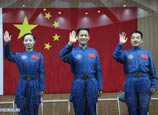
JIUQUAN, June 11 (Xinhua) -- China successfully launched its fifth manned spacecraft late Tuesday afternoon, sending three astronauts on the country's longest space trip.
With 10 astronauts and six spacecraft launched into space in a decade, China is speeding up on the path of exploration and building a home for Chinese in the galaxy.
At a see-off ceremony held hours before the launch, Chinese President Xi Jinping extended good wishes to the three astronauts.
"The mission's crew members carry a space dream of the Chinese nation, and represent the lofty aspirations of the Chinese people to explore space," said Xi.
The President later watched the launch at the Jiuquan Satellite Launch Center in northwest China, and shook hands with staff at the center after the successful launch.
Unlike the space trip of Yang Liwei, China's first astronaut who boarded the Shenzhou-5 spacecraft in 2003, of less than a day, the three astronauts will stay for half a month.
In its journey, Shenzhou-10 will dock with the orbiting space lab Tiangong-1 twice, once through automatic operation and the other manual, and a lecture will for the first time be given on board the assembled orbiter to a group of teenage students on the ground.
Compared with the previous nine Shenzhou spacecraft, the Shenzhou-10 is no longer experimental but considered an applicable shuttle system for transporting astronauts and supplies to orbiting modules.
"It is like developing a new type of car. You have to try it on roads of different conditions. Now trials are over and the car can be put into formal operation," said Zhou Jianping, chief engineer of China's manned space program.
On the other hand, the upgraded Long March-2F carrier rocket is technically the same as the one used with the Shenzhou-9 manned spacecraft.
"No alteration means that China's rocket technology is becoming mature," said Jing Muchun, chief designer of the carrier rocket.
This mission aims to further test technologies designed for docking and supporting astronauts' stay in space, as well as to use new technologies related to the construction of a space station, said Wu Ping, China's manned space program spokeswoman, at a press conference on Monday.




















![]()
